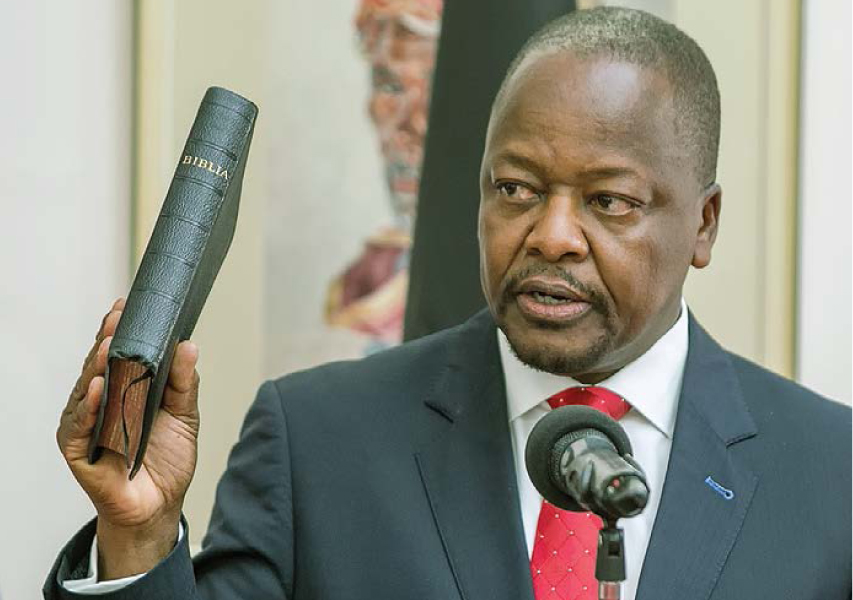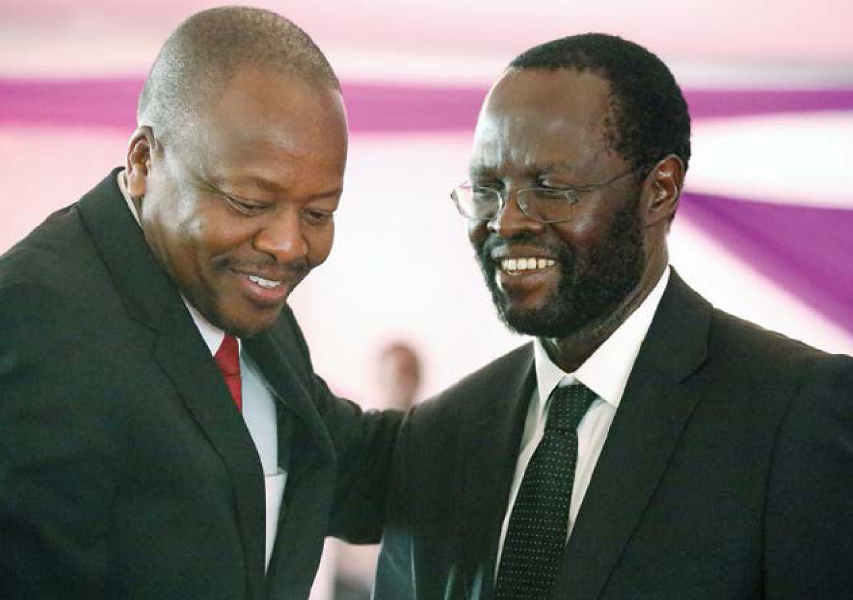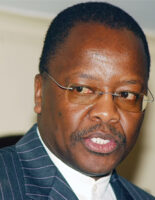
Mutahi Kagwe joined President Mwai Kibaki’s Cabinet as Minister for Information, Communications and Technology in 2005, replacing Raphael Tuju who moved to head the Ministry of Foreign Affairs. His Permanent Secretary was Bitange Ndemo, who replaced James Rege.
The 2005 date of Kagwe’s inclusion in the Cabinet is significant. It marked the final split of the coalition – National Rainbow Coalition (NARC) – that had won Kibaki the presidency three years before. The split was caused by the constitutional referendum of that year as several NARC affiliate parties felt short-changed by Kibaki’s first Cabinet in which they expected more slots. The disaffection of missing out on the so-called prime Cabinet positions festered all
the way into the referendum campaigns, with key coalition affiliates such as the Liberal Democratic Party (LDP) taking opposite sides in the plebiscite. President Kibaki led the ‘Yes’ side (symbolised by a banana) in the referendum while Raila Odinga, then the Minister for Roads and a member of LDP, led the ‘No’ side that was symbolised by an orange.
The ‘No’ side emerged victorious by rejecting the proposed new Constitution Kibaki had championed. To ward off the incessant squabbling and disenfranchisement in his Cabinet, he dismissed all seven ministers who had voted against the proposed document. At the time, Kagwe was the Member of Parliament for Mukurwe-ini Constituency in Nyeri District (present-day Nyeri County).
Kagwe’s rise to the Cabinet is best captured by the Bible verse in Ecclesiastes 9:11: “The race is not to the swift, nor the battle for the strong, nor does food come to the wise or wealth to the brilliant or favour to the learned, but time and chance happen to them all.” Veteran politicians with more leadership acumen and gravitas than Kagwe had
rebelled. In response, Kibaki fired these seasoned politicians, which was shocking because the majority of them had come to be largely viewed as indispensable. This was Kagwe’s “time and chance” as Kibaki sought loyalists to carry on his economic revival agenda. Loyalty overrode political experience. Kagwe took the job.
Born in 1958 and raised in Mukurwe-ini in Nyeri, Kagwe attended Kihate Primary School between 1965 and 1971 before joining Kagumo High School for his O’ and A’ levels between 1972 and 1977. He joined the University of Nairobi in 1978 and with a Bachelor of Commerce degree in 1981. In 1992 he graduated from the United States International University with a Master of Business Administration degree. Kagwe joined the Standard Group’s advertising division in 1987 and rose to become the commercial director. He left in 1994 and opened an independent media house (publishing The East African Chronicle and Business Chronicle), a regional consumer research consultancy named Research International-East Africa, an advertising agency and a public relations firm, Tel-Em Public Relations (EA) Limited. He was well versed and grounded in mass media communications, consumer products research and image making. To this end, he developed his own niche and thrived as a media maven with ‘gold card’ membership in the Marketing Society of Kenya and Kenya Institute of Management. In 2002, he plunged into politics, running on a NARC ticket.
In Parliament, Kagwe cosied his way to the influential post of chairman of the Parliamentary Committee on Finance, Trade, Tourism and Planning. Meanwhile, his background in marketing, consumer research and communications were turned into veritable assets at the ministry as at that time Kibaki was embracing newer forms and platforms of communications as envisaged under the United Nations World Summit for Information Society (WSIS) framework. Kenya could no longer afford to remain behind and isolated as the world incorporated newer forms of ICTs. Global pressure and targets streaming in from WSIS were piled on Kagwe and his team to fulfill and overcome.
The core of WSIS was premised on the info-knowledge society through information and communication technologies such as radio, television, newspapers, the Internet and telephony (cellular, fixed, satellite) among others. The seeds of WSIS were planted back in 1998 at the International Telecommunications Union (ITU) Plenipotentiary Conference in Minneapolis, USA, where Tunisia under Resolution 73 proposed the holding of a WSIS and placed it on the UN’s top agenda.
The first summit was held in Geneva in 2003, just as NARC was settling into power. It brought together over 50 heads of governments and dozens of ministers from 175 countries. That President Kibaki prioritised this meeting was not in doubt. Still recuperating from injuries sustained in a road accident just before the 2002 elections, he had dispatched his Vice President, Moody Awori, as head of the Kenyan delegation. “We are going through a historic transformation in the way we live, work, communicate and do business. We must do so not passively, but as makers of our own destiny,” said Kofi Annan, the UN Secretary General at the time. “Technology has produced the information age. Now it is up to all of us to build an information society.”
The tough task of turning Kenya into an info-knowledge society fell on Kagwe. In April 2004, the President initiated an ambitious and all-encompassing e-government strategy, setting up the Directorate of e-Government in the Office of the President. However, while on paper the telecommunications sector was liberalised, it was different in reality. The international gateway was still a monopoly that made both domestic and international communications expensive. All this was by design – vested interests that benefited from the monopolism stifled competition, dissuaded innovation and suppressed investments. In addition, the eastern coast of Africa remained the only major land mass in the world that lacked fibre-optic connectivity. To address this, in 2003 the African leaders and telecom operators had launched the East African Submarine System (EASSy) and sought to finance the undersea fibre-optic cable from Durban to Djibouti. The estimated budget was USD 200 million and start date was primed for 2006, with a projection that by mid-2007, the cable would be operational. Both the African Union’s New Partnership for Africa’s Development (NEPAD) and the World Bank backed EASSy.
However, the role of governments in the project, ownership structure and access became battlegrounds that delayed the project. The South African investors, who preferred a closed access yet expensive system with exorbitant fees, found themselves at odds with Kenya which was keen to provide faster, affordable, reliable and cheaper connectivity services to its broader populace.
Kagwe was obligated to move fast to secure affordable infrastructure and capacity building in readiness for the information and knowledge economy. Pooling in public- private partnerships, wealth creation and employment generation were the critical policy areas the Minister and his team had to deal with. PS Ndemo had this to say about those defining moments. “Kagwe was a well-known media personality, and he represented Mukurwe-ini Constituency that neighbours Othaya, President Kibaki’s constituency in Nyeri. He is sharp minded and a great listener. His first meeting with me was brief and succinct on the rules of engagement.
We agreed to be brutally honest with each other considering the fact that relations between the two offices can be obstructive to development and unnecessarily wasteful. He said, ‘My role is to give you political support while you run things at the ministry.’ The President, a charismatic, affable and confident person also offered support and told us, ‘Mambo ya Information and Communication Technologies ni yenu sasa. Sisi ni wazee. (Everything to do with ICTs is for you to deal with; we are now old), referring to himself and Francis Muthaura, the Head of Public Service and Secretary to the Cabinet. Muthaura was a career civil servant, congenial, with a quiet demeanour, who also gave us support to change things.”

At first, he had to get adequate and accommodative policies and legal framework to facilitate the burgeoning ICTs. Secondly, he had to ensure availability of affordable alternatives. Third, he had to find a way of getting a cheaper fibre-optic cable. Two painful decisions were made. Kagwe and Ndemo laid down a new ICT strategy in which they outlined a roadmap on the privatisation of Telkom Kenya. This way the government could free the sector from this State corporation’s monopoly on international gateway licences for mobile phone operators. It also called for the establishment of broadband wireless services, issuance of additional national licences and expansion of domestic fibre-optic networks through private sector involvement. The core of the plan was to launch Kenya as the continental ICT hub. The second decision involved leaving the expensive EASSy Consortium for an affordable ‘northern loop’ alternative.
Fibre-optic connectivity was Kagwe’s highest priority as it was much cheaper and faster than satellite options. Given the expectations and pressure from Kibaki, Kenya’s entire ICT strategy was hinged on it. In leaked diplomatic cables attributed to Robert Bellamy, the US ambassador to Kenya at the time, there was immense political will devoted to helping Kenya realise the quest to become an ICT hub. “Fibre-optic connectivity may sound too technical for some but the economic future of Kenya and her neighbours depends on it. If it doesn’t get it soon Kenya’s new ICT strategy may be dead on arrival,” read the leaked cables. “It is an ambitious strategy indeed. But it differs from other grandiose Kenyan government strategies of the past in that there is actually leadership in place working feverishly and against great odds to make it a reality.”
In November 2006, Kenya and the United Arab Emirates collaborated to establish.The East African Marine Systems (TEAMS) fibre-optic cable. This was a major score by Kagwe as he had found a smart way of achieving the country’s core ICT objectives as well as a polite way of nudging the EASSy movers to accelerate and accommodate other stakeholders.
Five months after signing the TEAMS partnership, Kagwe was at it again. On 6 March 2007, Safaricom, Kenya’s largest mobile phone network operator, launched M-Pesa, a mobile money transactions platform. This stands out as perhaps one of the greatest innovation successes of the seven-page strategy Kagwe and Ndemo were spearheading. M-Pesa revolutionised banking and money transfers and is today modestly ranked as “Africa’s leading mobile money service, with over 42 million active customers and almost 400,000 active agents operating across seven countries”.
The reality is that it is a global brand nurtured by the boldness of the Kenya government.
In October 2007, Alcatel-Lucent was awarded a USD 79 million contract to lay the TEAMS undersea cable from Fujairah to Mombasa. The cable began being laid in January 2008 and landed in Mombasa in June 2009. In the same year, the African Silicon Savannah Konza Technocity, occupying a 5,000-acre property south-east of Nairobi, was launched. By the time these milestones were being achieved, Kagwe had left the government after he lost his parliamentary seat to Kabando wa Kabando in the 2007 General Election. The successful trajectory he had initiated at the ministry continued long after he had left.
He took a sabbatical from politics and re-emerged in 2013, when he won the Nyeri County Senate seat. And just as he had managed when he first joined Parliament in 2002, he became chairman of the Senate Committee on Information and Technology while also serving on the Finance and Budget as well as the Liaison committees. In 2017, Kagwe contested the Nyeri governorship but lost to Dr. Gakuru Wahome. Two years later, he was appointed to the board of the Energy and Petroleum Regulatory Authority.
In early 2020, President Uhuru Kenyatta appointed Kagwe the Cabinet Secretary for Health and he instantly became the government’s voice on matters concerning the COVID-19 pandemic. Looking back, Ndemo acknowledged much of the success in the ICT ministry to the pragmatism accorded by President Kibaki and inventiveness of Kagwe, who correctly interpreted the President’s agenda.
“The success of the Kenyan ICT landscape was a series of accidental interventions starting with my appointment and that of Minister Mutahi Kagwe.” Ndemo said. “Kagwe happened to come from Kibaki’s Nyeri County and had unfettered access to the President. He was also smart, committed to seeing change, and the President respected his decisions. The President was a pragmatist, never prescriptive when delegating authority, a quality that gave the team leeway to properly change things.”
